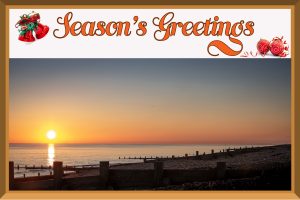We have arranged a short visit to Clapham Woods this coming Saturday 13th, which will be led by Graham Tuppen, to view the Bluebells there, as well as Wood Anemones (which are at their best now) and Primroses, plus any birds out and about. Meet at the car park at Clapham Church at 11am. It won’t be a long walk but can be a bit muddy in places, so please bear that in mind for footwear. Also due to limited space in the car park, please consider lift sharing if you can.
Hawthorn
Hawthorn, by Michael Blencowe
You could set your calendar by it. Around the first day of May, our ancestors would step outside to find foamy white clouds erupting across the Sussex countryside; the Hawthorn was blooming, spring was turning to summer. The sight was so visually stunning and so linked with the arrival of May that Hawthorn became the only British plant to be named after the month in which it blooms. Well, the name Hawthorn is derived from the Anglo-Saxon hagathorn (haga meaning hedge). I’m referring to that other name for Hawthorn: May.
Unlike the impetuous Blackthorn, which flowers in March before it’s even bothered to grow leaves, the Hawthorn is more dignified. It waits until it has clothed itself in undergarments of lobed leaves before it dons a resplendent gown of exquisite white flowers. This stunning costume and perfect timing meant Hawthorn took centre stage at May Day celebrations and it partied with Green Men, Morris Dancers, Maypoles and May Queens. ‘Gathering nuts in May’ actually refers to ‘gathering knots of May’ to make May Day garlands and decorations. Then, in the middle of the eighteenth century, tragedy struck. I don’t know about you, but I get thrown into disarray twice a year when the clocks change. My life would have gone into meltdown in 1752 as our whole calendar changed from Julian to Gregorian, and we lost an entire 11 days. In this new timeline, Hawthorn now found itself late for the party, blooming around May 12th.
It wasn’t the first time Hawthorn had been cast aside. Superstitions dictated that bringing Hawthorn indoors led to misfortune – even death. This could stem from the fact that Hawthorn blooms release trimethylamine, which gives the flowers that unpleasant smell of cat’s wee and attracts pollinating insects. It’s also a chemical formed in decaying tissue and reminded people of the smell of Black Death – and nobody wanted to be reminded of that.
I remember at primary school being taught ‘Ne’re cast a clout ‘til May is out’. I translated this gibberish into the fact that you should keep your warm clothes on until the end of May. I’ve only just discovered that ‘May is out’ refers to Hawthorn blooming. My clouts could have been cast weeks earlier. But the world has changed since I was a nipper – we’re warming up. For a temperature-sensitive plant like Hawthorn, the blooming times are changing again. Hawthorn is responding to climate change by flowering up to two weeks earlier than it was thirty years ago. It has crept back to bloom around May Day and is now more commonly seen flowering at the end of April. So this May Day, cast your clouts, get out into the great outdoors, and welcome the return of the real May Queen.
Sussex Wildlife Trust is a conservation charity for everyone who cares about nature in Sussex. Founded in 1961, we have worked with local people for over half a century to make Sussex richer in wildlife.
We rely on the support of our members. Please consider joining us. Your membership will help us challenge decisions that threaten wildlife, care for more than 30 nature reserves, and inspire the next generation about the wonders of the natural world. It’s easy to join online at sussexwildlifetrust.org.uk/join
Sussex Underwater Presentation 22 March
Ferring Conservation Group were privileged to welcome Sussex Underwater (Eric Smith accompanied by his daughter Catrine Priestley) to their March meeting to enthral members with their enlightening presentation together with beautiful film footage of the results of the successful campaign to rejuvenate the local underwater kelp forest.
It was apparent right from the start what a special relationship Eric and Catrine have with the narration slipping seamlessly between them as they began to set out the chain of events that resulted in this remarkable success.
Eric’s story began in 1959 at just 11 years old, kitted out with just a diving mask and snorkel purchased for 10 shillings from Woolworths, Eric began free diving off the Sussex coastline. During his initial dives he was mesmerised by the abundance of marine life including European Sea Bass, Black Sea Bream, European Lobster and Common Cuttlefish. Sadly, by the end of the century 96% of the kelp had disappeared along with the marine life it supported.
The great storm of 1987 and intensive fishing using heavy trawl nets, which were dragged along the seabed in the area and destroyed the seabed habitats, were mostly to blame. Even before these events Eric was greatly troubled at what he saw – in his words ‘this garden of Eden’ gradually being destroyed, and had begun campaigning tirelessly highlighting the damage this was causing and was later joined by his daughter Catrine. Eric still feels emotional today when he looks back and remembers seeing the bottom of the sea devoid of life and the Sussex underwater kelp forest virtually wiped out.
It wasn’t until 2021 that a new bylaw – supported by none other than Sir David Attenborough – banned trawl fishing in more than 100 square miles of seabed off Sussex. Encouragingly this has resulted in a great improvement of a healthy kelp ecosystem, providing an ideal nursery for juvenile fish and rare sea bream breeding on the sea bed again. This local story is of great importance not only to the UK but internationally too.
A BBC One programme ‘Our Lives; Our Kelp Forest’, (narrated by Chris Packham and now available on BBC iPlayer) outlined this amazing journey – filmed over three years this shows incredible scenes of Eric diving with giant 40-pound stingrays as well as witnessing the return of the mussel beds and is definitely worth watching.
To conclude the meeting Ed Miller took to the floor to update members with planning news:
The Certificate of Lawful Entitlement along with a Premises Licence have both been refused by Worthing BC in regard of the land on the north side of Marine Drive, Goring-by-Sea. The planning application for 47 houses at Kingston Lane, East Preston has been approved by Arun DC and a new application has been submitted for a bungalow to be built in the back garden of an existing property in Sea Lane, Ferring.
Wey and Arun Canal Trust Presentation 23 February
The February meeting had over 80 members and visitors present to hear an excellent presentation from Tony Pratt, a representative from The Wey and Arun Canal Trust. Tony explained that the canal formed the final part of a vital route from London to Portsmouth without going to sea. This became of great military importance, particularly during the Napoleonic Wars. Sadly, this was never a commercial success and as railways became the preferred mode of transport for goods, the canal was closed in 1871 and had been little used.
Over 100 years later The Wey and Arun Canal Society was formed which in 1973 became The Wey and Arun Canal Trust. This body of 3,000 members, volunteers and staff have been instrumental in restoring significant stretches of the canal. The Trust has a showcase site at Loxwood, West Sussex where it is possible to book boat trips and where canoeists and paddleboarders are welcome to use the waterway.
The Wey-South Path was one of the Trust’s earliest successes and is a long-distance footpath that runs either alongside or near to the canal route. Along this scenic route an abundance of wildlife can be viewed and also from the canal boats.
After a break for refreshments Graham Tuppen enlightened the audience with news of local wildlife sightings, including Chaffinches, a Brimstone butterfly and a Bumble Bee. The first Newt had been seen and a Heron taking numerous frogs from a pond in a local garden.
A Presentation by The Marine Conservation Society 26th January
Chiara Agnarelli, a local volunteer with the Marine Conservation Society, gave a talk to our 26 January meeting, highlighting the many threats to the sea’s wildlife, the world’s food supply, its function as a ‘carbon sink’ and its value for recreation. The main threat, she said was the increasing pollution from litter and sewage, but other problems like over-fishing of many species and ‘bottom trawling’ which scraped the sea floor, killing vast numbers of small animals and plants.
The Marine Conservation Society, founded in 1983, aims to work with governments, businesses and communities to reduce pollution, maintain edible fish stocks and keep our seas and beaches as pleasant unspoilt facilities for recreation. It works by influencing, campaigning and invigilating every aspect of damage to the marine environment, and by direct action with local amenity groups in Beach Cleans and cleaning the rivers and streams that often carry litter and other pollutants out to sea. Individuals too were being encouraged to reduce their own impact on the sea – by buying only responsibly-caught fish, avoiding single-use and unrecyclable plastic, and being careful with what they flush down the toilet.
Chiara said it was a long, hard battle to stop the unnecessary damage to the sea and its wildlife and there were many setbacks, but it was very good to see the number of conservation groups along the Sussex coast making such an impact. In West Sussex alone some 560 volunteers collected nearly 14,000 pieces of litter in 2022 and the figures for 2023 were expected to show much more being done.
David Bettiss said Ferring was doing its bit as the Conservation Group’s beach cleans and litter picking from the Rife banks were regular, well organised, and very well supported and it was good to hear of so much work being done at county and national level,
Graham Tuppen reported on work being done at Warren Pond to protect and enhance its wildlife, including a hibernaculum for over-wintering animals and insects, and on the bird life all over Ferring. He said the Big Garden Bird Count at the end of the month was expected to show a good number of Waxwings.
Ed Miller gave an update on local planning issues: the application for 47 houses in the Kingston Gap would almost certainly be refused by Arun DC and he was confident that the Persimmon appeal regarding the housing estate on Chatsmore Farm, would finally be dismissed following the Public Inquiry in February.
2024 Clean Up dates
The four Clean Up dates for 2024 have been arranged and details are included on the Beach Clean Dates section of this website. This year, there will be the Rife Clean in March, 2 Beach Cleans in May and September, and for the first time a Village Centre Clean in July.
More good work at Warren Pond
Following on from our Community project morning at Warren Pond in November, on a frosty and cold January morning we carried out some more useful practical improvements there to benefit the habitat.
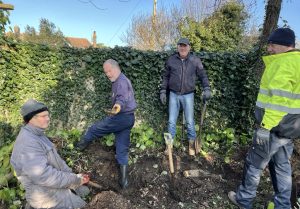 Firstly a Hibernaculum was constructed on the north side of the pond near to the fence line of Florida Road. This is basically an underground chamber that amphibians and reptiles can use throughout the winter to protect themselves from the cold, so this could benefit frogs, toads, newts and lizards. The chamber was dug to a depth of around 50cm, and then filled with some hardcore, then old tree branches and logs, and covered over with an amount of soil which had been dug out to create the chamber. The final result looked like a raised mound, and access by the wildlife can be gained in the gaps left betwen the logs and also some pieces of guttering which will act as walkways.
Firstly a Hibernaculum was constructed on the north side of the pond near to the fence line of Florida Road. This is basically an underground chamber that amphibians and reptiles can use throughout the winter to protect themselves from the cold, so this could benefit frogs, toads, newts and lizards. The chamber was dug to a depth of around 50cm, and then filled with some hardcore, then old tree branches and logs, and covered over with an amount of soil which had been dug out to create the chamber. The final result looked like a raised mound, and access by the wildlife can be gained in the gaps left betwen the logs and also some pieces of guttering which will act as walkways.
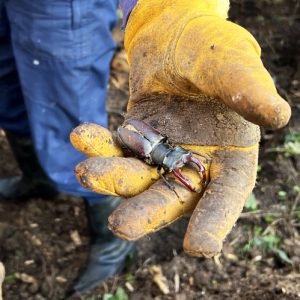 During the digging, we found an amazing total of SEVEN Stag Beetles, all of which were alive, and one large grub or larvae. All of them were carefully returned to their underground habitat for another day.
During the digging, we found an amazing total of SEVEN Stag Beetles, all of which were alive, and one large grub or larvae. All of them were carefully returned to their underground habitat for another day.
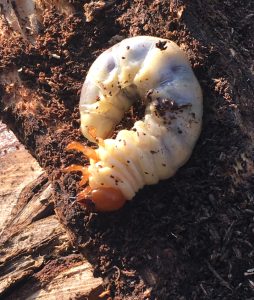 Nearby to the Hibernaculum we also started constructing a “dead hedge” – this is an upright structure consisting of woody garden cuttings contained within vertical wooden stakes, so it forms a perpetual hedge. This can be added to over time as it slowly rots down and will provide a great habitat for small birds such as Robins, Wrens and Dunnocks, as well as many small mammals again.
Nearby to the Hibernaculum we also started constructing a “dead hedge” – this is an upright structure consisting of woody garden cuttings contained within vertical wooden stakes, so it forms a perpetual hedge. This can be added to over time as it slowly rots down and will provide a great habitat for small birds such as Robins, Wrens and Dunnocks, as well as many small mammals again.
More sensitive work to improve the habitat is planned in partnership with the Parish Council in the months to come, and thank you to the good people who helped out on the day.
Warren Pond update
We held a very well attended Community Project morning at the pond at the start of November, and carried out a good amount of bramble and vegetation clearance on The Warren side of the pond. Thank you to all those who helped out and we managed to fill up the skip as usual.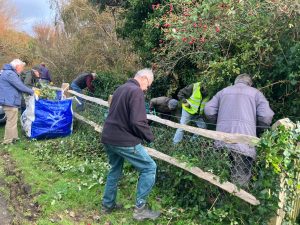
To follow on from that the Parish Council (who of course own the pond) arranged for a tree surgeon recently to carry out the heavier and more involved tree, bramble and vegetation clearance work, especially on the Florida Road side and also more on the west bank. Below are a “before” and a couple of “after” pictures so you can see the progress that has been made, and it has really opened up the views of the pond and the wildlife that visits, including the foxes.
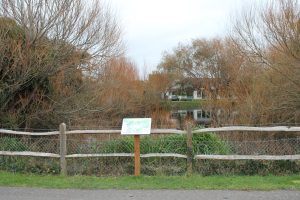
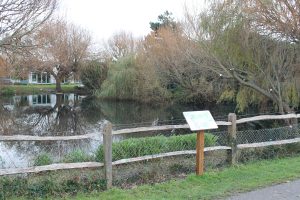 The water levels are very high which meant that the tree surgeon (who has done an excellent job) couldn’t access all the weeping willow and brambles, some of which was under the water surface, even though he did some of the work from his canoe. He intends returning to complete the work in the Spring when hopefully the water will have dropped, and the whole pond project is in fact an ongoing one to be continued over a number of years. We hope to construct a Hibernaculum soon there to benefit reptiles and amphibians, including the resident Great Crested Newts, as well as carrying out some small scale tree planting plus wild flowers on the banks and margins. We are also reinstating some birds nest boxes.
The water levels are very high which meant that the tree surgeon (who has done an excellent job) couldn’t access all the weeping willow and brambles, some of which was under the water surface, even though he did some of the work from his canoe. He intends returning to complete the work in the Spring when hopefully the water will have dropped, and the whole pond project is in fact an ongoing one to be continued over a number of years. We hope to construct a Hibernaculum soon there to benefit reptiles and amphibians, including the resident Great Crested Newts, as well as carrying out some small scale tree planting plus wild flowers on the banks and margins. We are also reinstating some birds nest boxes.
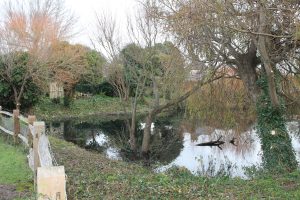 The main principle though is to maintain the pond and its surrounds as a wildlife sanctuary. As I’ve said many times this is one of the very few truly wild places in the village and desperately needs to be preserved as such for the benefit of the varied wildlife that call it home or frequent it.
The main principle though is to maintain the pond and its surrounds as a wildlife sanctuary. As I’ve said many times this is one of the very few truly wild places in the village and desperately needs to be preserved as such for the benefit of the varied wildlife that call it home or frequent it.
Worthing Buildings Lost and Saved
Ferring Conservation Group welcomed the Worthing Society to its November meeting, for a talk given by its Chairman, Sue Belton and Committee member David Clark. The Society much in common with our Conservation Group, is striving to preserve and conserve all that is best in our environment, and is a valuable member of the Protect our Gaps Alliance. It also reflects what we do in our History Group, in researching and presenting the town’s history but its main focus is on Worthing’s buildings – past, present and future – and the talk was entitled ‘Worthing’s Buildings, Lost and Saved.’
Sue said far too many historic buildings were demolished in the1960s and were replaced by extremely unattractive buildings and multi-storey car parks. This trend continued into the 1970s but was challenged by a redoubtable character, Mrs Pat Baring, who campaigned to save what was left, and founded the Worthing Civic Society in 1973. Among the fine buildings that were lost was the old Town Hall (built in 1836), the Theatre Royal in Ann Street (18th Century), Grafton House, the Esplanade Hotel (where Oscar Wilde wrote ‘The Importance of being Earnest’), and the 17th Century ‘Selden’s Cottage’ but the biggest planning disaster of all was the demolition of half the High Street leaving only two or three of the old town houses.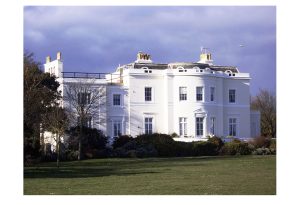
But although much had been lost a lot more had been saved. There were 212 buildings on the Statutory List and another 750 on Worthing Council’s local list. The Worthing Society was involved in saving much of this built heritage, working closely with English Heritage and the Borough Council. Beach House was one of its successes, along with the Dome Cinema and Stanford Cottage (now a Pizza House), where Jane Austen had written the unfinished novel, ‘Sanditon’. Now the Society was much involved with preserving these and other historic buildings but was also regularly consulted by the Council on planning applications and its redevelopment schemes like Teville Gate and Montague Place.
The talk was followed by tea and hot mince pies, and the usual update on local wildlife and planning applications and appeals, including the dismissal of the appeal on Lansdowne Nursery, one of the cases which the Protect our Gaps Alliance had taken up and won.
FCG 2023 Charity Christmas Cards
Our 2023 charity Christmas cards are now on sale. The image on the card this year is an excellent and atmospheric photograph of a Winter Sunset on Ferring Beach, taken by Mary Coe. The cards come in a pack of 10, and once again cost £5 per pack, with all proceeds going direct to Chestnut Tree House Children’s Hospice.
They will be available at our next Group meeting at Ferring Village Hall on Friday 24/11, and then at the Village Christmas Fair also at the Village Hall on the afternoon of Saturday 2/12. In addition they’ll also be on sale at Pinkerton’s Newsagents in Ocean Parade.

